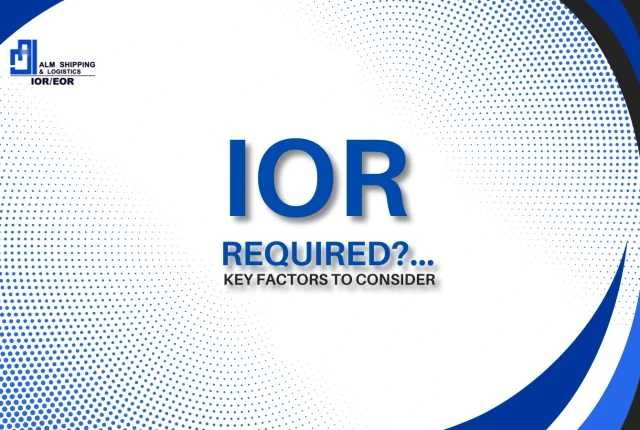
IOR Services vs. Local Entity: Which Is Right for You?
IOR Services vs. Local Entity Setup — Which Is Best for Your Business? | ALM Shipping & Logistics
Expanding globally is exciting, but it also brings complex compliance, tax, and legal minefields. One of the first strategic decisions a company must make is how to import and operate in new markets where you may not have a presence. Two common paths are: Using IOR (Importer of Record) services, where a third party takes on legal and customs responsibilities on your behalf.
Setting up a local entity, where you register a subsidiary, branch, or local company in that country.
🔍 What Is IOR (Importer of Record) Service?
Definition: An Importer of Record (IOR) is a legal entity designated to assume responsibility for importing goods into a country. The IOR ensures compliance with customs, pays duties/taxes, handles documentation, and interacts with regulatory bodies on your behalf.
You typically use IOR when your company does not have a legal presence in that country but still wants to import goods. The IOR “stands in” to take on that compliance and risk.
Key Responsibilities of an IOR
1. Classifying goods under correct tariff codes
2. Filing and submitting customs declarations
3. Paying import duties, VAT/GST, and import taxes
4. Ensuring product regulatory compliance (e.g. safety, licensing)
5. Liaising with customs authorities and handling audits
6. Managing release of goods from ports/warehouses
When IOR Makes Sense
You might prefer IOR when:
>> You’re entering a market on a trial basis
>> You want to reduce upfront investment and risk
>> You want fast go-to-market speed
>> Your import volumes are modest or sporadic
>> You lack local knowledge or partners
🏢 What Does Setting Up a Local Entity Involve?
Setting up a local entity means registering a company (or branch, subsidiary, or representative office) in the target country. You become a legal resident business there, with full rights and responsibilities.
Steps & Requirements
While specifics vary by country, typical steps include:
1. Review local laws & regulations corporate, tax, labor, licensing.
2. Choose structure subsidiary, branch, joint venture, representative office.
3. Name reservation & registration
4. Appoint local directors or statutory agents
5. Obtain business licenses, tax numbers, bank accounts
6. Register for VAT/GST, social security, and local taxes
7. Compliance, reporting, auditing
8. Hire staff, leases, operations, etc.
Types of Local Entity Structures
| Structure Type | Capabilities | Limitations / Considerations |
|---|---|---|
| Representative Office | Market research, branding, liaison | Cannot generally do full commercial operations or sales; minimal taxation risk |
| Branch Office | Full business operations under parent company | Often taxed as permanent establishment; parent liability |
| Subsidiary / Local Company | Full autonomy & limited liability | Higher setup cost, local compliance obligations, more administrative load |
Benefits of a Local Entity
Full control: you manage operations, pricing, hiring
Brand credibility: customers often prefer dealing with a “local” company
Tax advantages: potential incentives, local treaties
Access to contracts: some government or enterprise deals require local legal entities
Reduced dependency: not reliant on third-party IOR firms
However, these benefits come with more responsibility, cost, and complexity.
IOR vs. Local Entity: Pros & Cons
Here’s a side-by-side comparison to help you decide:
| Factor | IOR Services | Local Entity |
|---|---|---|
| Upfront cost & time | Low: you outsource compliance quickly | High: registration, legal, licensing, staffing |
| Operational control | Moderate: limited by IOR agreement | High: full oversight |
| Risk exposure | IOR assumes many compliance risks | You assume full local legal, tax, audit risks |
| Scalability | Good for moderate volume; may face per-unit costs | Better at scale: fixed costs amortized |
| Flexibility / Exit | Easier to scale down, terminate | More rigid: entity closure may be complex |
| Compliance burden | Largely handled by IOR | Entirely handled by you (or local team) |
| Credibility / contracts | Sometimes seen as third-party | Perceived as local, which helps in many markets |
Scenario Examples
Tech hardware firm entering a new APAC market: They might begin with an IOR to test demand before committing to full local entity investment.
Retail chain expanding in multiple cities: They may prefer local subsidiaries in each country to manage logistics, staff, and retail operations.
Decision Framework: Which Option for You?
Here’s a simplified decision path you can follow:
1. Volume & Forecast
Low to moderate, uncertain: lean toward IOR
High volume and long term: local entity favored
2. Regulatory & Risk Appetite
Prefer to outsource compliance risk → IOR
Willing to internalize and build local compliance → local
3. Control & Brand Strategy
Want to maintain direct oversight → local entity
Fine with partial control → IOR
4. Cost & Investment Capacity
Budget constrained → IOR
Capital available → local setup
5. Future Growth Plans
If expansion is only for a few markets → IOR may suffice
If you see broad expansion → entity may give better long-term ROI
A hybrid approach is also possible start with IOR, then transition some operations to a local entity as scale grows.
Best Practices & Tips
Perform due diligence: even with IOR, vet the partner’s compliance record.
Negotiate clear contracts: clarify responsibilities, limits, indemnities.
Plan exit strategies: ensure there’s clarity on how to move work into your own entity later.
Watch tax treaties & transfer pricing: local entity may allow optimized structures.
Track KPIs: compare cost per unit, risk exposure, speed, compliance errors over time.
Stay up to date on regulations: import rules evolve frequently.
FAQs
Q1. Can I use IOR services indefinitely, or is it only temporary?
Yes, many companies use IOR indefinitely, especially in markets where local representation is legally complex or costly. But as your scale increases, cost and control tradeoffs may prompt entity setup.
Q2. Does using an IOR mean I lose ownership of my goods?
No — using an IOR doesn’t mean you lose ownership. The IOR handles regulatory compliance but your title to goods remains as agreed in your contracts.
Q3. Are there markets where local entity is mandatory?
Yes — some countries legally require certain types of operations (e.g. distribution, sales) be handled by a registered local entity. Due diligence is essential.
Q4. Can I move from IOR to local entity later?
Absolutely. Many businesses begin with IOR and transition portions or all operations to their own entity when growth or stability justifies it.
Q5. What about hybrid models?
You can mix: use IOR for multiple smaller markets, and set up local entities in your highest-volume regions. This gives flexibility and optimization.
hoosing between IOR services and setting up a local entity isn’t a one-size-fits-all decision. Each has its strengths and tradeoffs:
IOR offers speed, lower upfront investment, and outsourced risk, making it ideal for testing new markets or managing moderate volumes.
Local entity delivers full control, long-term credibility, and operational leverage — best suited for mature markets or high-volume operations.






Leave a Reply